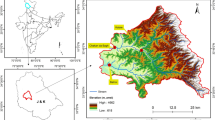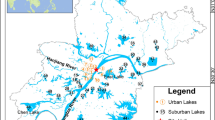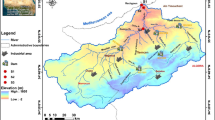Abstract
Small lakes of the boreal zone are highly sensitive indicators of both global environmental change and local anthropogenic pressure. This work presents the results of multidisciplinary study of three small, seasonally stratified lakes of NW Russia, conducted since 2002 to the present time. These lakes were subjected to various degree of impact by rural population and agricultural activity since the beginning of twentieth century but the population and anthropogenic pressure have decreased since 1990s. To monitor the recovering of these lakes from human impact and to relate the evolution of their hydrochemical parameters to short-term weather events and global climatic trend, we measured the lake water temperature and chemical composition (carbon, macro- and micronutrients, trace elements) in summer and winter over full depth of the water column. The pH and concentration of DIC, SO4 and H2S decreased over past decade. Concentrations of Si and nitrite increased over past 15 years, probably linked to progressive replacement of diatoms by cyanobacteria. We also recorded an increase in concentration of Cl and major cations in all lakes, likely linked to increasing connection to groundwater reservoirs. Some trace elements (Fe, Mn, Al, Zn, As, Pb) can serve as suitable indicators of on-going natural processes controlling lake response to external factors. Unlike widely reported global trend of DOC and Fe concentration increase in boreal surface waters of Europe and Northern America, such trend was not discernable in studied Fe-rich humic lakes. We conclude on the necessity of complex, multidisciplinary studies of small humic lakes in the boreal zone, because these “model” lakes can serve as important proxies of on-going environmental changes in highly abundant aquatic ecosystems of poorly characterized regions of NW Russia.







Similar content being viewed by others
References
Adamovich, B. V., T. V. Zhukova, T. M. Mikheyeva, R. Z. Kovalevskaya, T. A. Makarevich & A. A. Zhukova, 2017. Eutrophication, oligotrophication, and benthiphication in Naroch Lakes: 40 years of monitoring. Journal of Siberian Federal University. Biology 10(4): 379–394.
Agafonova, S. A. & N. L. Frolova, 2007. Features of ice regime of Northern Dvina rivers’ basin. Water Resources 34(2): 123–131.
Björneras, C., G. A. Weyhenmeyer, C. D. Evans, M. O. Gessner, H.-P. Grossart, K. Kangur, I. Kokorite, P. Kortelainen, H. Laudon, J. Lehtoranta, N. Lottig, D. T. Monteith, P. Nõges, T. Nõges, F. Oulehle, G. C. Riise, J. A. Rusak, A. Räike, J. Sire, S. Sterling & E. S. Kritzberg, 2017. Widespread increases in iron concentration in European and North American Freshwaters. Global Biogeochemical Cycles 31: 1488–1500.
Bortolini, J. C., P. R. L. da Silva, G. Baumgartner & N. C. Bueno, 2019. Response to environmental, spatial, and temporal mechanisms of the phytoplankton metacommunity: comparing ecological approaches in subtropical reservoirs. Hydrobiologia 830(1): 45–61.
Chupakov, A. V., A. A. Chupakova, O Yu Moreva, L. S. Shirokova, S. A. Zabelina, T. Y. Vorobieva, S. I. Klimov, O. S. Brovko & O. S. Pokrovsky, 2017. Seasonal dynamics of dissolved carbon in contrasting stratified lakes of the subarctic. Boreal Environment Research 22: 213–230.
Collins, S. M., S. Yuan, P. N. Tan, S. K. Oliver, J. F. Lapierre, K. S. Cheruvelil, C. E. Fergus, N. K. Skaff, J. Stachelek, T. Wagner & P. A. Soranno, 2019. Winter precipitation and summer temperature predict lake water quality at macroscales. Water Resources Research 55(4): 2708–2721.
Dmitrieva, E., 2015. Forest on-line. Closed factories of cellulose and paper processing. Internet publication on portal http://www.lesonline.ru/analitic/, https://bizon.ru/news/view/news_id/198016. Accessed 10 Jan 2020
Drabkova, V. G., 1974. Production processes in lakes of Kola Peninsula. In Drabkova, V. G. (ed.), Lakes of Different Landscapes of Kola Peninsula, Part 2, Hydrochemistry and Hydrobiology. Nauka Press, Leningrad: 63–77.
Frey, K. E., D. I. Siegel & L. C. Smith, 2007. Geochemistry of west Siberian streams and their potential response to permafrost degradation. Water Resources Research. https://doi.org/10.1029/2006wr004902.
Enneking, J. C., 2002. Control of carbon disulfide emissions from viscose processes. Environmental Progress 21(3): 169–174.
Evans, C. D., D. T. Monteith & D. M. Cooper, 2005. Long-term increases in surface water dissolved organic carbon: observations, possible causes and environmental impacts. Environmental pollution 137(1): 55–71.
Goryaeva, Kh A, 1961. The soil. In Goryaeva, Kh A (ed.), Agroclimate handbook on the Arkhangelsk region. Hydrometeoizdat, Leningrad: 220.
Grönlund, E., 2012. The recovery of two polluted subarctic lakes-towards nutrient management or a pristine state? Water 4: 793–814.
Hastie, A., R. Lauerwald, G. Weyhenmeyer, S. Sobek, C. Verpoorter & P. Regnier, 2017. CO2 evasion from boreal lakes: revised estimate, drivers of spatial variability, and future projections. Global Change Biology. https://doi.org/10.1111/gcb.13902.
Huerta-Diaz, M. A., A. Tessier & R. Carignan, 1998. Geochemistry of trace metals associated with reduced sulfur in freshwater sediments. Applied Geochemistry 13(2): 213–233.
Huser, B. J., M. N. Futter, R. Wang & J. Fölster, 2017. Persistent and widespread long-term phosphorus declines in boreal lakes in Sweden. Science of the Total Environment 613-614(Supplement C): 240–249.
Kokryatskaya, N. M., S. A. Zabelina, A. S. Savvichev, O. Y. Moreva & T. Y. Vorovieva, 2012. Seasonal biogeochemical and microbiological studies of small lakes in taiga zone of Northwestern Russia (Arkhangelsk Province). Water Resources 39: 105–117.
Kolosov, R. R., A. S. Prokushkin & O. S. Pokrovsky, 2016. Major anion and cation fluxes from the Central Siberian Plateau watersheds with underlying permafrost. IOP Conference Series 48: 012018.
Koroleff, F., 1983a. Total and organic nitrogen. In Grasshoff, K., M. Ehrhardt & K. Kremling (eds.), Methods for Seawater Analysis. Verlag Chemie, Weinheim: 162–168.
Koroleff, F., 1983b. Determination of phosphorus. In Grasshoff, K., M. Ehrhardt & K. Kremling (eds.), Methods for Seawater Analysis. Verlag Chemie, Weinheim: 125–136.
Kosten, S., V. L. M. Huszar, E. Bécares, L. S. Costa, E. van Donk, L. A. Hansson, E. Jeppesen, C. Kruk, G. Lacerot, N. Mazzeo, L. De Meester, B. Moss, M. Lürling, T. Nöges, S. Romo & M. Scheffer, 2012. Warmer climates boost cyanobacterial dominance in shallow waters. Global Change Biology 18: 118–126.
Kravtsova, M. A. & N. P. Chuprov, 2005. The dynamics of wood consumption and forestry in Arkhangelsk region. Izvestija vusshikh uchebnukh zavedeni. Lesnoi Zhurnal 1–2: 123–130.
Kvasov, D. D., 1990. History of lake Ladoga, lake Onega, Pskovsko-Chudskoe lakes, lake Baikal and lake Hankey. Nauka Press, Leningrad: 280.
Malov, A. I., 2013. The use of the geological benchmarks to assess the residence time of groundwater in the aquifer using uranium isotopes on the example of the Northern Dvina basin. Lithology and Mineral Resources 48: 254–265.
Markensten, H., K. Moore & I. Persson, 2010. Simulated lake phytoplankton composition shifts toward cyanobacteria dominance in a future warmer climate. Ecological Applications 20(3): 752–767.
McCullough, I. M., K. S. Cheruvelil, S. Collins & P. A. Soranno, 2019. Geographic patterns of the climate sensitivity of lakes. Ecological Applications 29(2): e01836.
Moiseenko, T. I., V. A. Dauvalter & L. Ya. Kagan, 1997. Mountain lakes as indicators of air pollution. Water Resources 23(5): 669–682.
Moiseenko, T. I., V. A. Dauvalter & I. V. Rodyushkin, 1998. The mechanisms of the cycle of natural and anthropogenic introduced metals in the surface waters of the Arctic basin. Water Resources 2: 231–243.
Moiseenko, T. I., N. A. Gashkina, Yu A Bylinyak, L. P. Kudryavtseva & S. S. Sandimirov, 2006. Zonal features of the chemical composition formation of water in small lakes in the European part of Russia. Water Resources 33(2): 163–180.
Moiseenko, T. I., N. A. Gashkina, A. N. Sharov, O. I. Vandysh & L. P. Kudryavtseva, 2009. Anthropogenic transformation of the Arctic ecosystem of Lake Imandra: trends towards restoration after a long period of pollution. Water Resources 36(3): 1–14.
Monteith, D. T., J. L. Stoddard, C. D. Evans, H. A. de Wit, M. Forsiu, T. Høgasen, A. Wilander, B. L. Skjelkvale, D. S. Jeffries, J. Vuorenmaa, B. Keller, J. Kopácek & J. Vesely, 2007. Dissolved organic carbon trends resulting from changes in atmospheric deposition chemistry. Nature 450(7169): 537–540.
Nandini, S., S. S. S. Sarma, E. Jeppesen & L. May, 2019. Preface: shallow lakes research: advances and perspectives. Hydrobiologia 829(1): 1–4.
Oleinikova, O. V., O. Y. Drozdova, S. A. Lapitskiy, V. V. Demin, A. Y. Bychkov & O. S. Pokrovsky, 2017a. Dissolved organic matter degradation by sunlight coagulates organo-mineral colloids and produces low-molecular weight fraction of metals in boreal humic waters. Geochimica et Cosmochimica Acta 211: 97–114.
Oleinikova, O. V., L. S. Shirokova, E. Gerad, O Yu Drozdova, S. A. Lapitsky, A. Y. Bychkov & O. S. Pokrovsky, 2017b. Transformation of organo-ferric peat colloids by a heterotrophic bacterium. Geochimica et Cosmochimica Acta 205: 313–330.
Oliver, S., S. Collins, P. A. Soranno, T. Wagner, E. H. Stanley, J. R. Jones, C. A. Stow & N. R. Lottig, 2017. Unexpected stasis in a changing world: lake nutrient and chlorophyll trends since 1990. Global Change Biology 23(12): 5455–5467.
Paerl, H. W. & V. J. Paul, 2012. Climate change: links to global expansion of harmful cyanobacteria. Water Research 46(5): 1349–1363.
Petrov, V. V. & A. Semenchuk, 2017. Ecological-hydrogeochemical conditions of the North-Dvina basin groundwater. Regional Geology and Metallogenia 71: 84–92.
Pokrovsky, O. S., L. S. Shirokova, S. A. Zabelina, T. Y. Vorobieva, O. Y. Moreva, S. I. Klimov, A. V. Chupakov, N. V. Shorina, N. M. Kokryatskaya, S. Audry, J. Viers, C. Zoutien & R. Freydier, 2012. Size fractionation of trace elements in a seasonally stratified boreal lakes: control of organic matter and iron colloids. Aquatic Geochemistry 18: 115–139.
Pokrovsky, O. S. & L. S. Shirokova, 2013. Diurnal variations of dissolved and colloidal organic carbon and trace metals in a boreal lake during summer bloom. Water Research 47: 922–932.
Pokrovsky, O. S., 2019. Primary data of hydrochemical parameters of the Rotkovets group of lakes (Svyatoe, Beloe and Nazarovskoe), sampled in 2002–2018. Research Gate repository.https://www.researchgate.net/publication/335607630_Rotkovetz_Lakes_hydrochemical_data_2002-2018. https://doi.org/10.13140/rg.2.2.25569.04960.
Rumyantsev, V. A. & V. G. Drabkova, 2002. Lake Ladoga: Past, Present, Future. Nauka Press, St. Petersburg: 326.
Rumyantsev, V. A., V. G. Drabkova & A. V. Izmailova, 2015. Lakes of European Part of Russia. LEMA Press, St Petersburg: 392.
Semenov, A. D., 1977. Handbook on Chemical Analyses of Continental Surface Waters. Gigrometeoizdat, Leningrad: 541.
Shirokova, L. S., O. S. Pokrovsky, O. Y. Moreva, A. V. Chupakov, S. A. Zabelina, S. I. Klimov, N. V. Shorina & T. Y. Vorobieva, 2013. Decrease of concentration and colloidal fraction of organic carbon and trace elements in response to the anomalously hot summer 2010 in a humic boreal lake. Science Total Environment 463–464: 78–90.
Shirokova, L. S., L. Kunhel, J.-L. Rols & O. S. Pokrovsky, 2015. Experimental modeling of cyanobacterial bloom in a thermokarst lake. Aquatic Geochemistry 21(6): 487–511.
Shirokova, L. S., T. Y. Vorobieva, S. A. Zabelina, S. I. Klimov, O. Y. Moreva, A. V. Chupakov, N. M. Makhnovich, V. A. Gogolitsyn, E. I. Sobko, N. V. Shorina, N. M. Kokryatskaya, A. A. Ershova & O. S. Pokrovsky, 2016. Small boreal lake ecosystem evolution under the influence of natural and anthropogenic factors: results of multidisciplinary long-term study. Water 8(8): 316.
Shirokova, L. S., R. Bredoire, J.-L. Rols & O. S. Pokrovsky, 2017. Moss and peat leachate degradability by heterotrophic bacteria: fate of organic carbon and trace metals. Geomicrobiology Journal 34(8): 641–655.
Shirokova, L. S., A. V. Chupakov, S. A. Zabelina, N. V. Neverova, D. Payandi-Rolland, C. Causserand, J. Karlsson & O. S. Pokrovsky, 2019. Humic surface waters of frozen peat bogs (permafrost zone) are highly resistant to bio- and photodegradation. Biogeosciences 16: 2511–2526.
Smetanin, A. V. & L. M. Smetanina, 2013. Arkhangelsk region: sources, potential, modernization. Arkhangelsk, IPTs SAFU, ISBN 978-5-261-00705-0.
Sobek, S., B. Söderbäck, S. Karsson, E. Andersson & A.-K. Brunbergn, 2006. A carbon budget of a small humic lake: an example of the importance of lakes for organic matter cycling in boreal catchments. Ambio 35: 469–475.
Titova, K. V., N. M. Kokryatskaya, T. A. Zhibareva & E. A. Vahrameeva, 2017. Distribution of sulfur compounds as a result of the sulfate reduction process in freshwater lake Svyatoe. Transactions of Karelian Research Centre of Russian Academy of Science. Limnology 10: 28–37.
Trifonova, I. S., 1998. Phytoplankton composition and biomass structure in relation to trophic gradient in some temperate and subarctic lakes of northwestern Russia and the Prebaltic. Hydrobiologia 369(370): 99–108.
Vinberg, G. G., 1975. Peculiarities of aquatic ecosystems. Zhurnal Obshchesvta Biologii 28(5): 538–545.
Walvoord, M. A., C. I. Voss & T. P. Wellman, 2012. Influence of permafrost distribution on groundwater flow in the context of climate-driven permafrost thaw: example from Yukon Flats Basin, Alaska, United States. Water Resources Research 48: W07524.
Yeghicheyan, D., C. Bossy, M. Bouhnik Le Coz, C. Douchet, G. Granier, A. Heimburger, et al., 2013. A compilation of silicon, rare earth element and twenty-one other trace element concentrations in the natural river water reference material SLRS-5 (NRC-CNRC). Geostandards and Geoanalytical Research 37: 449–467.
Zhang, J., J. Hudson, R. Neal, J. Sereda, Th Clair, M. Turner, D. Jeffries, P. Dillon, L. Molot, K. Somers & R. Hessleinc, 2010. Long-term patterns of dissolved organic carbon in lakes across eastern Canada: evidence of a pronounced climate effect. Limnology Oceanography 55(1): 30–42.
Zhou, Y., T. A. Davidson, X. Yao, Y. Zhang, E. Jeppesen, J. Garcia de Souza, H. Wu, K. Shi & B. Qin, 2018. How autochthonous dissolved organic matter responds to eutrophication and climate warming: evidence from a cross-continental data analysis and experiments. Earth-Science Reviews 185: 928–937.
Acknowledgements
This work was supported by the RFBR (Grants No. 17-05-00342), FASE Russia under the theme No. AAAA-A18-118012390200-5; No. AAAA-A18-118012390167-1; UroRAN No AAAA-A18-118012390252-4.
Author information
Authors and Affiliations
Corresponding author
Additional information
Publisher's Note
Springer Nature remains neutral with regard to jurisdictional claims in published maps and institutional affiliations.
Guest editors: Tom Jilbert, Raoul-Marie Couture, Brian J. Huser & Kalevi Salonen / Restoration of eutrophic lakes: current practices and future challenges
Electronic supplementary material
Below is the link to the electronic supplementary material.
Rights and permissions
About this article
Cite this article
Shirokova, L.S., Chupakov, A.V., Kokryatskaya, N.M. et al. Variability of hydrochemical parameters of small boreal lakes under natural and anthropogenic factors (case study of NW Russia). Hydrobiologia 847, 4653–4670 (2020). https://doi.org/10.1007/s10750-020-04193-2
Received:
Revised:
Accepted:
Published:
Issue Date:
DOI: https://doi.org/10.1007/s10750-020-04193-2




